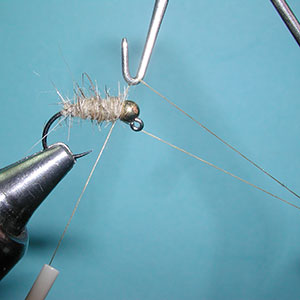







| 1. Attach the wire ribbing to the bottom of the hook shank and wrap to the bend of the hook above the barb.
|
 |
|
| 2. Select a Wood-duck Flank feather that is flat on the top. Clip the tip with about 15-20 fibers. Measure the tip for a length to be about the same as the hook shank and attach the fibers at the bend of the hook. |
 |
|
| 3. Dub along the hook shank creating a tapered body to just past the midpoint of the shank. |
 |
|
|
4. Then wrap the ribbing to the end of the dubbing and tie off. |
 |
|
| 5. Using the feather that you clipped the tip from, utilize the remaining fibers for a collar hackle. Position the feather at the top of the shank with the ends just protruding beyond the hook bend. Using your thumb and index finger, distribute the fibers around the shank and tie off. |  |
|
|
6. Trim the hackle tag and secure with thread wraps. |
 |
|
| 7. Add more dubbing for a thorax. This dubbed area should be larger in diameter than the body with a more buggy appearance. Cal would use his dubbing tool to create a dubbing loop that facilitated a looser appearance. Whip finish for a small thread head. |  |
|
| 8. Add more dubbing for a thorax. This dubbed area should be larger in diameter than the body with a more buggy appearance. Cal would use his dubbing tool to create a dubbing loop that facilitated a looser appearance. Whip finish for a small thread head. |  |
©2022 Steve Schalla
This page is not to be copied without
my explicit permission.